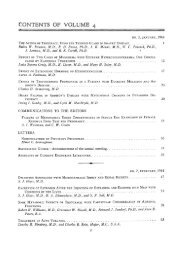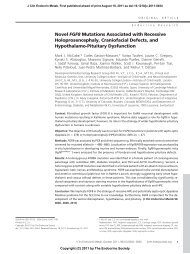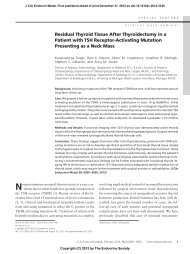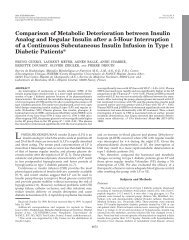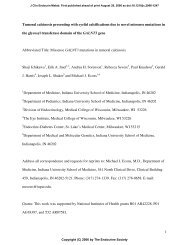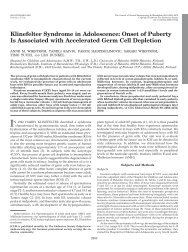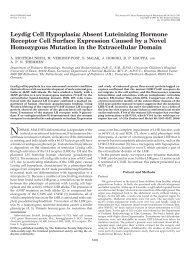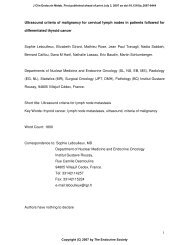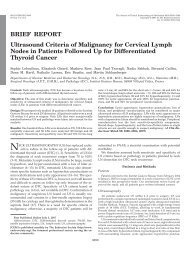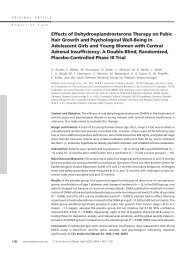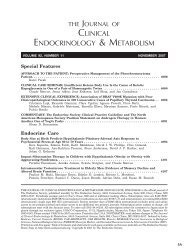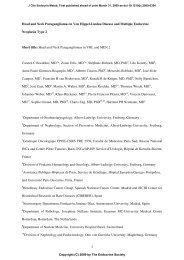Title: Neuropsychological Features in Primary Hyperparathyroidism ...
Title: Neuropsychological Features in Primary Hyperparathyroidism ...
Title: Neuropsychological Features in Primary Hyperparathyroidism ...
Create successful ePaper yourself
Turn your PDF publications into a flip-book with our unique Google optimized e-Paper software.
PHPT, mean performance levels on these tests were not <strong>in</strong> a range suggestive of cl<strong>in</strong>ical depression or<br />
anxiety. Depressive symptoms improved - the pattern of change <strong>in</strong> depressive symptoms over time differed<br />
between the groups (group by time <strong>in</strong>teraction; p=0.024) such that there was no difference between the<br />
control and postoperative groups (PHPT 5.2±1.0 versus control 3.7±0.8, p=0.28) after parathyroidectomy.<br />
Trait anxiety but not state anxiety decreased after parathyroidectomy <strong>in</strong> the PHPT group compared to<br />
basel<strong>in</strong>e. However, there were no differences <strong>in</strong> change over time between the groups for either trait or state<br />
anxiety (p=0.152 and p=0.184, respectively).<br />
Cognitive Function<br />
Memory: Those with PHPT had worse scores for both immediate and delayed recall of contextually related<br />
material (immediate: 17.2±0.9 versus 20.6±0.8, p=0.01; delayed: 12±0.9 versus 16.0±0.7, p=0.002; Figure<br />
2). Both tests improved to levels that were no longer different from control subjects after parathyroidectomy<br />
(immediate: 20.0±0.8 versus 20.0±0.7, p=0.97; delayed: 14.5±0.9 versus 15.7±0.8, p=0.36), and the change<br />
over time differed between normal and PHPT subjects (p=0.003 immediate and p=0.009 delayed recall).<br />
Immediate, but not delayed, word list recall (SRT) was also worse at basel<strong>in</strong>e <strong>in</strong> the PHPT group (immediate:<br />
49.2±1.3 versus 53±1.1, p=0.04; delayed: 6.8±0.4 versus 7.9±0.4, p=0.064). Neither immediate nor delayed<br />
recall changed with surgery (Figure 3). No differences were found between PHPT and controls <strong>in</strong> visual<br />
memory (Table 3). Both groups improved to similar extents over time, consistent with a learn<strong>in</strong>g effect.<br />
Other cognitive functions: Non-verbal abstraction was worse <strong>in</strong> the PHPT group (39.9±1.9 versus 45.6±1.6,<br />
p=0.041, Figure 4). While scores <strong>in</strong> both PHPT and control subjects improved over time, those with PHPT<br />
improved to a greater extent, so that they were <strong>in</strong>dist<strong>in</strong>guishable from normal subjects (49.5±2.3 versus<br />
50.5±1.9, p=0.74; group by time <strong>in</strong>teraction: p=0.036). Visual concentration and attention as measured by the<br />
RTD or Digit Symbol test was similar <strong>in</strong> the PHPT and control groups (Table 3). While target detection did<br />
not change over time, the PHPT group improved compared to basel<strong>in</strong>e on one test of visual concentration<br />
and attention (Digit Symbol test), while the control group did not (between groups change over time,<br />
9



